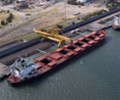

European market participants are finding it increasingly difficult to resell their excess stock in Asia due to strong supply-side fundamentals for thermal coal in the region, a trend that was widely prevalent over the past several weeks, sources told S&P Global Commodity Insights.
Lower-than-expected demand, decent natural gas storage levels and renewable generation led to mounting coal stockpiles in Europe over the past three months, following which traders flocked to the Asian market with their cargoes.
While interest of Asian buyers toward European cargoes was heard in May and June, strong supply from Indonesia and Australia as well as robust domestic production by China and India has lowered interest for the former.
“The supply coming out of Asia is fresh stock. Even though European coal is largely matching the Asian price, the quality of coal seems to have deteriorated after lying at ports for so long and getting transported thereafter,” an India-based trader said. “Moreover, demand is weak in Asia and buyers are spoiled with choices, so expectations of a decline in prices further prevail.”
China and India — the two biggest drivers of the Asian thermal coal market — have largely remained on the sidelines putting pressure on Indonesian coal prices, while South African prices have also suffered a setback due to domestic logistical challenges.
Dip in thermal coal supplies
According to data from S&P Global Commodities at Sea, around 400,000 mt thermal coal was loaded from the ports of north-western Europe in June, down from 500,000 mt in May, 700,000 mt in April and 600,000 mt in March.
The data shows that thermal coal supplies to India and China have been rising from Russia and Australia. Indonesia remains the largest exporting nation of thermal coal by a huge margin to both these countries combined, however, the volume of Indonesian coal reaching the Indian and Chinese shores have been falling every month since March.
S&P Global data shows that the price of low-ash Australian 5,500 kcal/kg NAR coal averaged $179.1/mt FOB in 2022, up 109.6% year on year, as global thermal coal prices surged with the Russia-Ukraine conflict disrupting trade flows and weather-related problems that impacted output amid rebounding demand. The grade was assessed at $90.80/mt July 19. The Kalimantan 3,800 kcal/kg grade coal was priced at $41.50/mt FOB July 19, down from $66/mt a year ago. The price of this grade had touched $75/mt level in November-December 2022.
“Asian buyers are waiting for further price declines. Thus, larger buyers remain content to opportunistically acquire tonnage through the summer heatwave. Therefore, we believe US exports will remain volatile as exporters jockey for position (and price) in the global seaborne market, targeting Asian demand,” analysts at S&P Global said.
A US-based trader added that “the difficulty with reselling does not surprise me. Many sellers are stumped by a pop in the freight market too. The European economy is very weak. With the heat, the generation from wind should be low, with solar high. But gas must be cheap enough, it continues to displace coal.”
According to additional sources, European gas storage is currently at around 80% full, but the gas demand for generation vs available tonnage, demonstrates the clear availability of spot LNG in the market.
“EU natural gas and coal prices came off hard last week. Economic, nor weather demand is enough to counter significant inventories of energy to stimulate prices coal and gas prices throughout Europe,” a US-based trader said.
US supply endures downside risk
In the alternative supplying regions, tonnage from the US is also facing a similar issue after having a strong demand from Asia, which is now set to be lessened by the downside risk of US exports to Europe for the remainder of 2023.
“US thermal coal exports increased in May to 3.6 million mt, up nearly 500,000 month-on-month and approximately 800,000/mt year-on-year as Asian demand remained strong ahead of their summer demand and monsoon season,” analysts at S&P Global said.
US thermal exports trended higher in May as expected though gains were modest driven by Asian demand to flush out stocks ahead of the summer peak season and ahead of the monsoon seasonal lull in India.
Looking ahead, market participants anticipate that the continued low coal generation in Europe will enable more availability of stock that will “hopefully be sold off to the Asian market” if demand picks up.
In the Atlantic Basin, elevated European coal stocks, at 6.6 million mt at ARA ports, according to the most recent data from the ports, are set to stay elevated as coal generation continues to decline.
“At this moment, we see that the re-loadings are decreasing somewhat, but we do not see any major differences with previous years,” a Europe-based trader said.
Source: Platts





